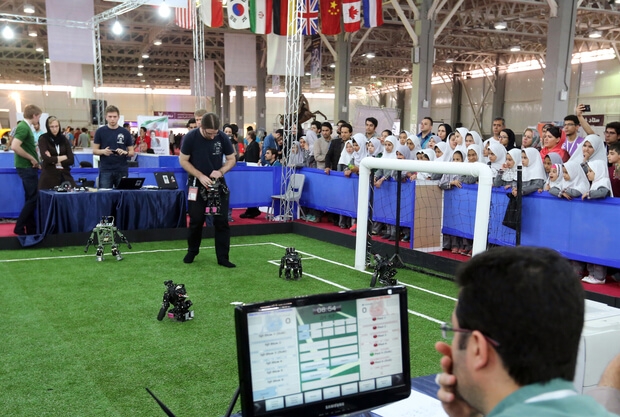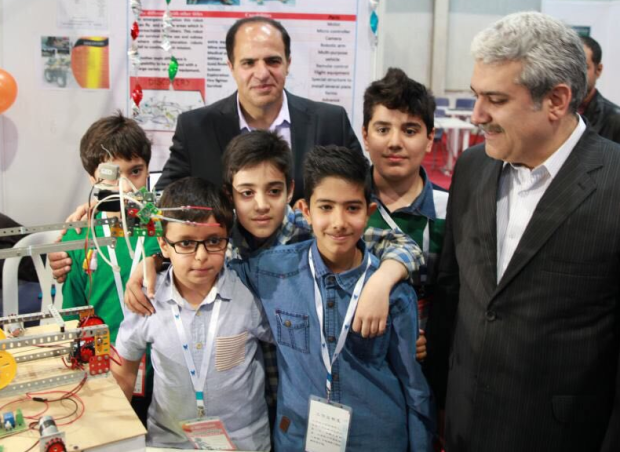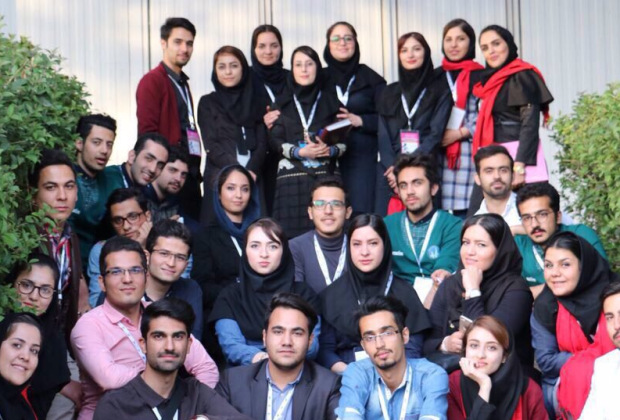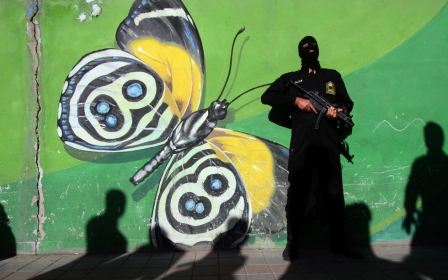March of Iran's mobile bots on display at Tehran Robocup

TEHRAN - Cyrus, Avicenna and Jegar are battling it out on the pitch in the Standard Platform League at Tehran's International Fairground as team members watch and cheer on the players. While the speed and skills on display are hardly at Premiership level, these toddling footballers are not human - they are 53cm-high autonomous mobile robots, a pioneering field in which Iran is quietly becoming a major player.
Iran's burgeoning success in the field of mobile robotics is not as well known as its nuclear and ballistic development, but there was no doubt about the technological prowess on display at the Robocup Iran Open in Tehran earlier this month.
The atmosphere was buzzing as contestants, spectators and members of the press shuttled between robotics exhibitions and contests throughout four large halls in the fairground. It is hard to imagine a starker contrast between the scene at Robocup and many of the dated images and narratives still used to depict Iran and Iranian society.
It's the 11th such competition to take place in Tehran, drawing international teams from a host of countries including Germany, China and the UK competing alongside several teams from universities across Iran. One of these was the co-organisers of the event, Qazvin Islamic Azad University (QIAU)'s MRL team, based at the university’s Mechatronics Research Laboratories centre.
Zahra Nouri forms part of the MRL team competing in the Robocup Standard Platform Football League. She sees a future in which robots will take on more and more human characteristics as the technology advances. “My vision and hope for the future is that robots can start learning and developing autonomously, like humans do,” she says.
Reflecting this, MRL team in particular chose traditional Iranian names for their humanoids: Cyrus, Avicenna and even Jegar - a fictional donkey character from a famous children’s puppet show Kolah Ghermezi.
Nouri chose the field of robotics for her higher education, her specific interest was in robot programming. Since there was no course specialising in this at QIAU at the time, she decided to teach herself through reading books on the subject and using the internet. She is now a member of one of the most globally renowned Iranian teams in the Robocup SPL.
Having triumphed at the annual Robocup championship held in China last year, the MRL mobile robotics team came first at this year’s Iran Open and will go on to compete in the championship in Leipzig, Germany this summer.
'The future is in robotics'
In recent years, Iran has been the leading nation in terms of annual growth in scientific production. Science and engineering are popular majors among Iranian youths, with women comprising 70 per cent of the country’s 4.5 million university students in science and engineering departments.
While there was much global fanfare last year surrounding the unveiling of Iran’s Surena III - a life-sized humanoid that was under development for four years - the country’s expertise and human capital extends far further when it comes to robotics. The University of Tehran, Amirkabir University, QIAU and Khajeh Nasir Toosi University of Technology were some of the Iranian institutions with teams competing at this year’s Robocup, and many of their students were eager to show their passion and enthusiasm for the field of robotics.
Pouya Mansournia's interest in robotics began in his early teens, after which he engaged in self-study and practical learning. He now forms part of QIAU's MRL team, working in the field of mobile robotics. For him, the significance of mobile robots lies in their capacity to gain access to often unreachable areas and carry out crucial tasks, such as in post-earthquake retrieval missions, disarming bombs and putting out fires.
Rescue robots are indeed playing vital roles in today’s world, and were used, for instance, in the search for victims and survivors after the 11 September attacks in New York. “I hope to see the technology keep moving forward and start to be applied more practically in everyday life,” says Mansournia.
Similar views were held by many of the other participants in the competitions. Armin Agharazy is a 21-year old student at Khajeh Nasir Toosi University, who competed with his team KN2C in the Robocup SSL.
According to him, the future is in robotics, and he hopes “to see a day where robots are playing football against humans”. One of his more short-term dreams was to rank between first and third places in the Small Size Robot League. While this was not achieved this year - KN2C ranked fifth behind University of Tehran’s Immortals, MRL and Zhejiang University’s ZJUNlict team - Armin is eager to keep moving forward and participate in future contests.
Robots under the sea and in the air
Although the competitions were the main focus of the event, there were also sections dedicated to exhibitions, where student teams were displaying the various talents of their robotic machinery. The MRL team was showing their model of a remotely operated vehicle (ROV) that can dive to over 100 metres underwater.
Predominantly used by the oil and gas industry for things such as assisting in offshore oil field development and connecting pipelines, the tasks undertaken by ROVs can include deep-sea rescue operations as well as the inspection and recovery of objects from the ocean floor.
ROVs have become evermore essential in exploring uncharted territory and providing critical assistance after occurrences such as chemical and oil spills. Masoud Hoseinali-Pour of the MRL team says that while such technology already exists among foreign and global companies, standard prices for ROVs are prohibitive, and they would like to ultimately “put more cost-efficient machines on the market”.
Also on display were unmanned aerial vehicles, more commonly known as drones, which were developed by students from several Iranian universities. These autonomous robots, capable of vertical flying and landing, feature laser scanners that enable them to identify their surroundings. In addition to simple demonstrations of their capabilities, some of the student teams were engaging in playful drone-racing with each other. Among the keen observers here, and amidst all the other robotic sports taking place at Robocup, were students on school trips from all over Iran, developing their own spark of interest in the field.
Regardless of the futuristic setting, characteristic aspects of Iranian tradition were still present. According to Sander Van Dijk of the UK team Bold Hearts, the Iranian teams were very hospitable hosts, from offering to lend hardware and chats about how to solve software issues, to inviting members of foreign teams to their homes after the competitions.
“Even though RoboCup is a competition and there may be some shouting at each other and the referee during hectic games, explains Van Dijk, “interaction with other teams is most of the time very friendly, as it's also a joint scientific effort.”
His team ultimately triumphed in the humanoids Kid-Size League - featuring football teams with four players of up to 90cm each - managing to beat the Islamic Azad University of Parand in the finals, as well as Free University of Berlin’s FUmanoids in a penalty shoot-out, with fourth place going to the University of Hamburg’s Bit-Bots.
Growth despite sanctions
Although the recently lifted sanctions placed on Iran had presented obstacles, such as the higher prices of essential imported raw materials or even the complete inability to procure them, scientific research and development, including in the field of robotics, was by no means curbed altogether. According to Abbas Edalat of Imperial College London, Iranian scientists refused to see failure as an option, finding ways around the difficulties such as smuggling in the required parts, building them from scratch or making do without them.
Despite ingenuity in overcoming those challenges, however, in his view, the end of sanctions will mean much more freedom of movement in terms of participation in international conferences and collaborative work for Iranian researchers, as well as increased ability to buy the necessary equipment and materials.
Similar sentiments were widely echoed among the students and participants of this year's Iran’s Robocup. There was a general consensus that although the sanctions had complicated matters, they in no way held back the country’s scientific development, indeed even strengthening it by forcing the industry to become more self-reliant.
“Sanctions forced us to use economical methods to develop our activities and as a result we stood independent from foreign countries,” says Agharazy, who also added that innovation became a must to “create and repair many required parts”.
While the lifting of sanctions may present novel opportunities for robotics in Iran, the country’s researchers and developers have thus far proved more than capable of keeping up with global standards. Its full reintegration will, however, introduce a welcome element of competitiveness to the industry.
Iran's robots are truly on the march.
New MEE newsletter: Jerusalem Dispatch
Sign up to get the latest insights and analysis on Israel-Palestine, alongside Turkey Unpacked and other MEE newsletters
Middle East Eye delivers independent and unrivalled coverage and analysis of the Middle East, North Africa and beyond. To learn more about republishing this content and the associated fees, please fill out this form. More about MEE can be found here.







